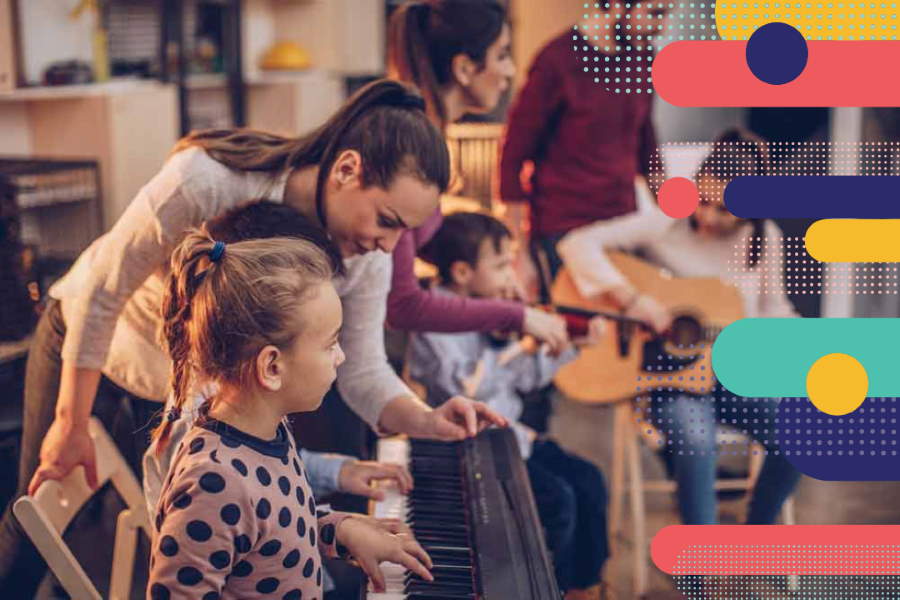April is National poetry month, so I want to share with you how to use poetry in the music classroom. Of course, poetry is used in a language arts classroom or to teach reading, but it can also be used to show music. In this blog post, you’ll learn how poetry and music are similar and how to use poetry in the music classroom, even with the youngest of students.

Rhythm and Steady Beat
When you read a piece of music, there are many notes to be played with several different rhythms. If these notes are not played using the correct rhythms and with a steady beat, it will sound like a mess.
A perfect example of this is rap. The rapper says their rhyme using a steady beat and with repetition. If the rapper doesn't speak the rap using an appropriate rhythm, it will not sound put together and will have no fluidity.
Try It
If you've ever gone to a live poetry reading, can you imagine if the person reading the poem went fast, then slow, then stopped, then restarted, then went fast again, it would sound kind of awkward.
Great poems, just like great music, should be read using rhythm (like I mentioned in the first section) and the tempo that was chosen should be used throughout with only subtle fluctuations.
But, depending on what type of poetry you’re doing with your students, adding tempo can make it more interesting to listen to.
Try It
For example, maybe you’re reading a poem about a train moving down the track. Have students pat to the steady beat. Then, when you read the parts about the train moving faster, their hands will move faster to match the words you’re reading. Then, you can have a good closing discussion about tempo and how you applied it to that poem.
Dynamics
Listen to a child who is just learning to read and he will more than likely be very monotone. Also, listen to a child who is in beginning band, and he will probably play at one dynamic level. Once the child gets older and better at his craft, he’ll start reading and playing music with more heart and expression. His reading and playing will come to life by using louds, softs, and silences. Then, it becomes an emotional experience for the audience who is listening in.
When reading a poem, if there aren’t any dynamics or changes in the way it’s being spoken, it’s becomes very hard to listen to. Use poetry to explore dynamics in music.
Try It
Have your students read a piece of poetry together and when your hands go up, their voices should get louder. When your hands go down, their voices should get softer. Then, you can easily apply this same exercise to teaching singing or any of the instruments as well.
Okay, now that we’ve explored how poetry and music are similar, let’s look at an example of how to use poetry in the music classroom. In this poem, you’ll learn how to use poetry to create music with your students.
Poetry Example, "Bonefish, Bluebird"
You’ll find the “Bonefish, Bluebird” lesson plan on the TeacherVision website. In this blog post, I’m going to use this poem as an example of how to teach a poetry lesson and align it with music.
This is one of my favorite poems to teach to kids. I like it because it’s short enough to memorize, yet there is plenty of music to be made from it.
Bonefish, bluebird, sheep, and flea.
Chickadee, doodlebug, robins in a tree.
Fly in the cream jar, frog in the pool.
Clap for all the children here at school.
Here's how I would teach this poem to make it musical:
- Pat the steady beat while reading the poem.
- Clap the rhythm of the words (which basically means to clap each sound.)
- Make each line a different dynamics level. For instance, the first line can be soft (p), second line a little louder (mp), third line even louder (mf), and the last line loud (f).
- Assign a different movement to each line while still saying the dynamics levels that you created. For the first line, you could squat, then bend at the waist, then stand, then stand on your toes with your arms in the air.
- Add rhythm instruments to play the beat and rhythm that you used body percussion to perform at the beginning of the lesson.
While reading poetry in your classroom, don’t just read it, but explore it. Don’t be afraid to get up and move to the words, use body percussion, add instruments, and speak it with varying tempos and dynamics.
How do you teach music and poetry similtaneously? Share with us on Instagram, Facebook, Twitter, and Pinterest.
Jessica Peresta is passionate about providing other music teachers, especially those right out of college or new to teaching elementary music, with the music education resources, lesson plans, teacher training, and community you've been looking for. She believes your domestic life outside of school should be spent soaking up time with family and friends and your music teacher life while at school should not leave you feeling defeated, but should be a joyful, exciting, and rewarding experience. To find out more about Jessica and her passion, head to www.thedomesticmusician.com.










